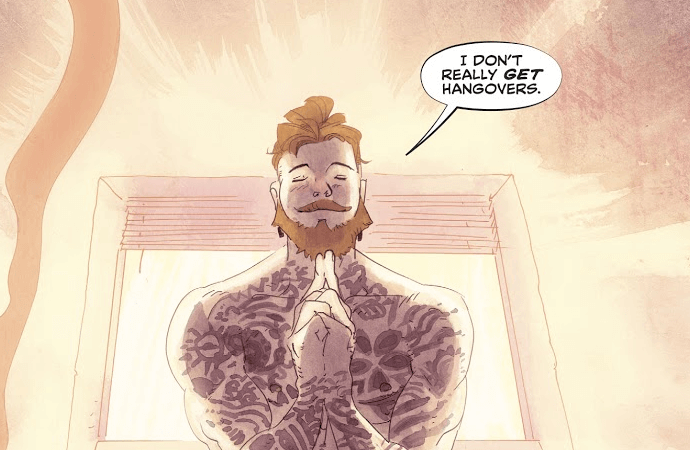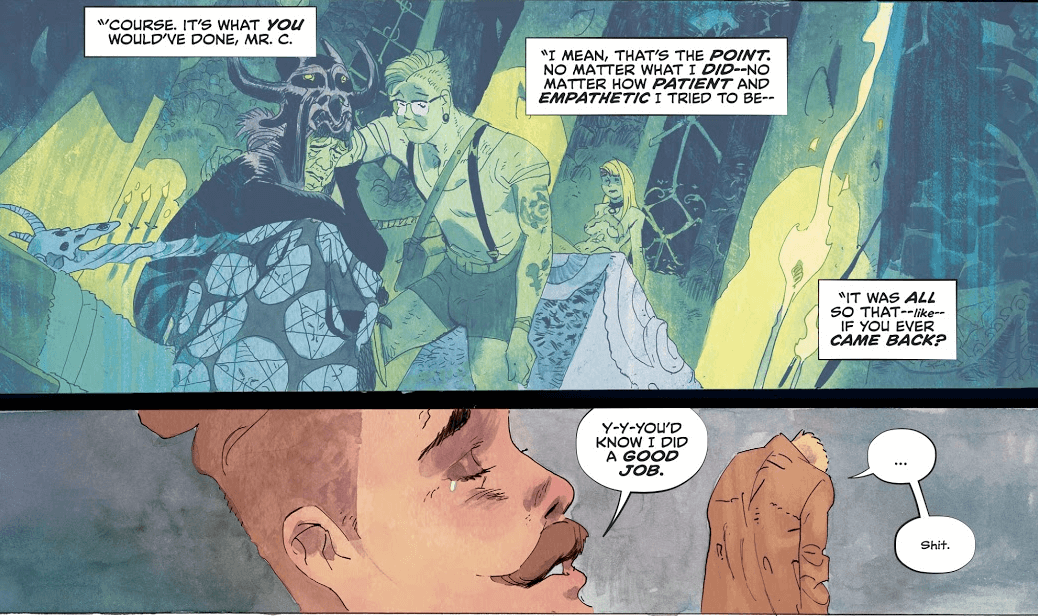I appreciate that this series never does exactly what I expect of it, and John Constantine: Hellblazer #5 is no different.
John Constantine: Hellblazer #5
Jordie Bellaire (Colorist), Matías Bergara (Artist) Aditya Bidikar (Letterer), Simon Spurrier (Writer)
DC Comics
March 25, 2020
By the end of issue #4, I was convinced that issue #5 would have Tommy Willowtree revealed to be a fraud, or at the very least a secret asshole. I refuse to let go of that belief entirely because I still do not trust a man who feels the need to tell others about his “anti-privilege retreat,” but what the Hellblazer team do with Willowtree is more interesting than making him a surprise baddie.
The issue opens with Constantine waking in Willowtree’s apartment, hungover and disheveled on a mattress of potato skins. Willowtree—who, naturally, doesn’t get hangovers—invites him out for smoothies and a story about where he got the artifacts and the directive to pass them on to Constantine, the supposed new Magelord of England. Naturally, Constantine dips out on that engagement, and Willowtree fades somewhat into the background, even as the story continues to revolve around him. There’s a conspiracy afoot, one much bigger than cursed crows and angels in Peckham Rye.
That there was something bigger going on isn’t exactly a revelation; Willowtree pointed out the pattern of magical events targeting “foreigners” in the previous issue. With all of these cases stemming not just from magic run wild but rather a potent mixture of nationalism, xenophobia, and racism, it’s clear that while magic may be expressing these attitudes, it is not the cause of them. The first arc’s angels were magical, but arose because of nationalism. This arc’s crows are magical, but somebody taught them to target the marginalized; crows have no concept of “foreign.”
That’s one of the things I’ve always loved about Hellblazer. The nature of comics is such that few problems are solved forever—there’s always another enemy to defeat, another world-shattering cataclysm to prevent. In Hellblazer, those problems are frequently the same as in our world; hence the xenophobia, the references to Brexit, the rough edges of everything we’re currently going through cutting through the fiction, never quite letting us escape fully into fantasy. Constantine may solve the problem of the crows or the problem of the angels, but it won’t stop until the cause is addressed.
It’s bleak! It has always been bleak, even as it has been funny or charming or profound, because despite all of the magic, Hellblazer‘s world is so close to ours as to be uncomfortable. It’s a series that wears its relationship to the real world with pride by way of shame, pointing to the rotten things in our society and forcing us to stare directly at them, acknowledging that they, not just demons or devils or assholes with wands, are a true source of evil.
The fight doesn’t end. It’s the machinations of the powerful—the wealthy, the famous, the literally magically powerful—that create these problems, and it’s everyone else who is affected by them.
It feels as if I’ve gone off the rails from the issue itself, but these ideas are crucial to my understanding of the series and its goals. In my review of issue #2, I noted that the use of a slur intended to demonstrate a character’s racism didn’t land for me because we already knew he was bad. In this arc, I’ve questioned Tommy Willowtree’s intentions because a white man appropriating the spiritual practices of multiple religions and “respectively” hitting on women strikes me as suspect. That’s my own cynicism at work, but, by nature of the series being Hellblazer, I don’t feel wrong about it, even if I am technically wrong.
When I mentioned earlier that what the series does with Willowtree is more interesting than making him a clear villain, what I mean is that he isn’t a cause of the problems. He’s a kick in the pants for Constantine, sure, but he—and his referring to the marginalized as “foreigners”—like the crows, like the angels, is a symptom of a larger problem. The problem of Willowtree can’t be solved right now, because the cause still exists.
It’s also possible that I am entirely wrong and the lack of exploration of why the Peckham Rye racist felt safe saying a racist slur to Constantine exists for the same reason that Tommy Willowtree is good, actually—because the series isn’t interested in interrogating Constantine and Willowtree’s complicity in racism. It’s possible, but I don’t know that I entirely believe it. If Constantine’s mission is to be the best version of himself, and thus far that has primarily been accomplished by literally just taking only every other opportunity to be a jackass rather than every single one, he still has a long way to go.
Accepting complicity in violent power structures is an uncomfortable one. It’s a lifelong journey, not one that’s wrapped up in one big fight with a demon or whatever. That journey, like the rest of the series, is dark and depressing as you wander further in and see how much racism and heterosexism and patriarchy and all the other darkness is not just a facet, but rather the basis of the world we live in.
As I said, it’s bleak. But just as the series has always been bleak—just as life has always been bleak—there are moments of levity, too. Matías Bergara’s artwork and Jordie Bellaire’s colors are at their most cartoonish and wonderful in this issue; Constantine is practically a caricature of a man and Bergara’s artwork captures that expertly. Every expression is intense, every gesture performative. Where Campbell’s art was gritty and textured, Bergara’s work is lighter, with more space to breathe thanks to his use of both empty space and heavy inks. Thematically, this echoes both Willowtree’s personality and the more irreverent tone of the arc—things are still dire, but there’s more levity to it.
It all feels a dimension above reality, with Bellaire’s colors setting this arc visually apart from the previous one. The colors throughout are wonderfully contrasted, with scenes alternating and sometimes mish-mashing beautiful pastels together with nasty browns and oranges signifying bodily functions, guts, and gore. It’s playful, despite the seriousness of the subject matter. Bellaire’s colors splash together the awful shit in the world next to beauty, never shying away from either. It’s jarring at times, but in a way that works with the narrative to tell a more complete story.
Aditya Bidikar’s lettering continues to be a star in its own right, guiding the reader through Simon Spurrier’s often dialect-heavy writing. Bolded text sometimes feels superfluous to me, but Bidikar’s skillful use lends the dialog a wonderful dramatic (but not unrealistic) cadence. The lettering brings in the delivery of film noir—it’s not meant to evoke reality, but rather a highly stylized take on the way people speak. It’s fun, more importantly, letting the reader enjoy the subtleties and delights of the way words sound rather than just delivering the dialog to serve the story’s events.
What works about John Constantine: Hellblazer is not any one individual piece, though all of them—writing, art, colors, letters, et cetera—do work exceptionally well on their own. What works is the way each folds neatly into the story that’s being told, especially with the changes in artists. Aaron Campbell’s art may not have worked for the Tommy Willowtree arc, and Matias Bergara’s art may not have worked for the first arc. Even as the series embraces discord as a theme, the work is harmonious, a real triumph in the larger Hellblazer series.




